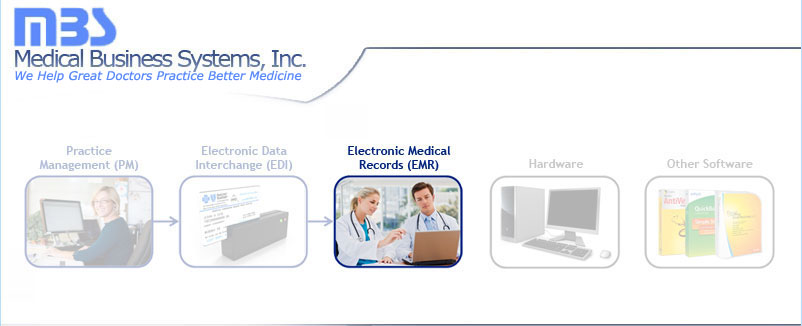Electronic Medical Records (EMR)
An electronic medical records software system can greatly improve the clinical operations of your medical practice. From small process improvements to innovative clinical care approaches, an EMR system will allow you to handle a patient from first visit to discharge.
- Documenting
Using EMR software’s documenting ability, doctors can record details of a patient’s visit, such as chief complaints, diagnoses, progress notes, and prescriptions, in an electronic patient chart customized by type of visit (e.g. routine check-up) or patient disease or condition (e.g. diabetes or foot pain). These customized templates help guide the clinical exam and increase thoroughness. The completed electronic patient chart can then be added to or used to create a patient’s electronic medical record. - Document Management
This powerful component of an EMR system allows you to manage and consolidate all of your patients’ clinical records. Past progress notes, treatments, and prescriptions, as well as lab results, hospital inpatient records, and other external clinical data can all be added to a patient’s electronic medical record, allowing doctors to have immediate access to a patient’s comprehensive medical history. The EMR system will also allow you to electronically exchange patient information with other healthcare providers (e.g. referred specialist or hospitals). - Electronic Prescriptions
The electronic ordering feature allows healthcare providers to communicate directly with pharmacies regarding patient prescriptions. Healthcare providers can submit drug prescription orders to a specific pharmacy while pharmacies can electronically verify refill and other information with healthcare providers. By eliminating hand-written patient-delivered prescriptions, electronic ordering also greatly reduces the possibility of prescription mistakes. - Internal & External Communications
EMR systems contain interoffice and external electronic communication capabilities. Doctors, assistants, and staff can exchange patient information with one another quickly and easily through the EMR system, while patients can also exchange secure messages with doctors, receive lab test results, and complete registration paperwork prior to their appointment through a secure patient portal feature available in some software solutions. - Care Management
Following a patient visit, doctors can activate a recommended treatment plan for the patient according to their disease or condition that includes automated reminders for follow-up appointments, prescription refills, check-up calls, etc., making attentive and personalized care effortless. - Analysis & Reporting
With a database of electronic patient data, doctors can run analyses on specific treatments and procedures or generate reports based on patient demographics or conditions to evaluate treatment success rates, outcome statistics, group trends, and other useful measurements.
best replica watch site 2021
hermes cape cod replica watch
time of replica legit
To learn more about the electronic medical records solutions that we sell and service, please click on a link below:
